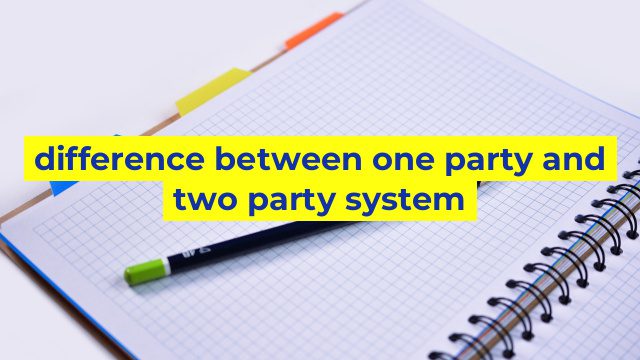The Difference Between One-Party and Two-Party Systems: What You Need to Know
In modern democracies, there are two predominant types of electoral systems: one-party systems and two-party systems. The primary difference between the two is the number of political parties that are represented in a given election. In this article, we’ll explore the key characteristics of each system and examine the pros and cons of each approach.
One-Party Systems
In a one-party system, there is only one political party that holds power. This party may have originated as a revolutionary movement, or it may have been established through other means such as a military coup or political consolidation. In this system, other political parties may exist, but they have little to no chance of winning elections or influencing policies.
One-party systems are often associated with authoritarian and totalitarian governments. They can be effective in maintaining law and order, but they can also be criticized for limiting individual freedoms and stifling dissent. The lack of effective opposition can lead to corruption and the abuse of power.
Two-Party Systems
In a two-party system, two major political parties dominate electoral politics. These parties typically have distinct platforms and ideologies, and they compete for control of the government through elections. In the United States, for example, the Republican Party and the Democratic Party are the two major parties.
The two-party system provides voters with a clear choice between two competing visions for the country. It also fosters a healthy balance of power, as the opposition party can serve as a check on the ruling party’s policies. However, the two-party system can also lead to polarization and a lack of diversity in political representation. Smaller political parties and independent candidates have little chance of being elected, which can limit the diversity of ideas in the political sphere.
Conclusion
Ultimately, the choice between a one-party and two-party system is a complex one that depends on a variety of factors, including cultural norms, historical context, and the preferences of voters. Both systems have their advantages and disadvantages, and both can be effective in certain contexts. As with any electoral system, the key is to ensure that the voices of all citizens are heard and that their interests are represented in the corridors of power.
As a business owner, understanding the political climate in your region can help you make informed decisions about investing and expanding your operations. Whether you are operating in a one-party or two-party system, it’s important to stay informed about the policies and positions of the major political parties and to engage with lawmakers and other stakeholders to ensure that your voice is heard.
Table difference between one party and two party system
| Aspect | One Party System | Two Party System |
|---|---|---|
| Definition | A political system where only one political party is allowed by law to hold power | A political system where two major political parties dominate the government, alternating in power |
| Representation | No representation for minority groups, as only one party holds power | Representation for minority groups, as both parties can compete for their votes |
| Competition | No competition, as only one party is allowed to participate in elections | Competition between the two parties can result in better policies and accountability |
| Stability | One party can maintain stability but can lead to lack of innovation and progress | Two parties can bring stability but also can lead to gridlock and lack of progress |
| Citizens’ Role | Citizens do not have much influence, as their choices are limited and controlled by the ruling party | Citizens have a more significant role in shaping political decisions, as they can choose between two options |
